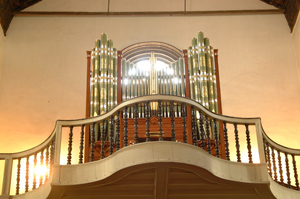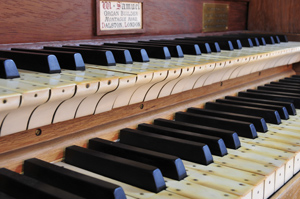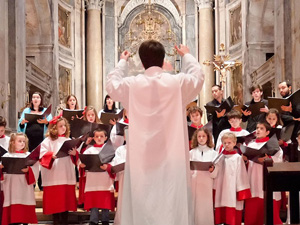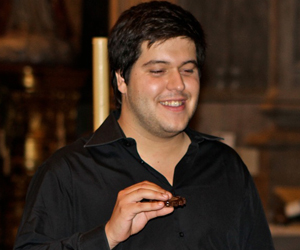 Saturday, 20 October, 9.30 p.m.
Saturday, 20 October, 9.30 p.m.
Funchal Cathedral
Pequenos Cantores da Basílica da Estrela
David Paccetti Correia, organ
Pedro Rollin Rodrigues, conductor
In Portugal, the composition and performance of sacred music, in particular of specifically liturgical music, entered into a phase of decadence from 1834 onwards, as a consequence of the establishment of the liberal regime (the expropriation of the Church, the closing of the religious orders and compulsory closing of the Patriarchal Seminary).
Very different was the future of sacred music in the countries from which the repertoire in this concert comes. Indeed, in countries such as Germany, France and Great Britain, the systematic practice of excellent liturgical music was maintained throughout the last two centuries, both in terms of compositions and of performance. This concert’s programme draws principally on the cultivation and expression of a great European trend from which Portugal remained distant.
The motet Ave verum op. 2, no. 1 (1887-1902) by Elgar, is a meditation on the Eucharist; it was intended to be sung at Mass, at the moment of the elevation of the Holy Sacrament. Edward Elgar (1857-1934) was the most famous British composer of his time. Sacred music for choir and for organ represents a small, but significant, part of his output. The eleven movements of the Vesper Voluntaries op. 14 (1890), for solo organ, would have been used to open and close evening prayers at church.
Josef Gabriel Rheinberger (1839-1901) was professor of organ, piano and composition at the Munich Conservatory. His stylistic influences were various: Johannes Brahms, Franz Schubert and Johann Sebastian Bach. A prolific composer, he is remembered principally for his extensive output for organ, which numbers more than one hundred pieces. His sacred music includes twelve Masses, a Requiem and a Stabat Mater. In the Missa Puerorum op. 62 (1871-1872), the composer’s masterly style is clearly audible: the harmony is very much of its time, making recurrent use of chromaticism and altered chords, and the melodies cantabile.
Flor Peeters (1903-1986), born in Belgium, did not aim to follow the official European avant-garde, preferring to write music in a familiar language and adopting classical forms. He collaborated with Jules van Nuffel in the production of Nova Organi Harmonia – organ accompaniments for the Gregorian chant repertoire for the entire liturgical year. He was principal organist of the Cathedral of St Romuald in Mechelen, for whose choir and organ he composed all his sacred music. His great models were the organist-composers Marcel Dupré, Charles Tournemire and César Franck, whose influence may be heard in his use of canon and in his thematic development. Peeters had a predilection for fluid melodic lines, influenced by the tradition of Gregorian chant and Franco-Flemish polyphony.
César Franck (1822-1890) was born in what is now Belgium. Panis Angelicus (1860) and Ave Maria FWV 62 (1863) come from the time during which he was organist of the Church of Saint-Clothilde, in Paris, when he was at last finding his own personal style, beginning a evolution in the perception of what sacred music should be, moving away from operatic and martial styles. From this moment, composers and organists could no longer write, play or improvise as they had before. Panis Anglicus is a section from the Mass for Three Voices in F major op. 12 FWV 61; its positioning between the Sanctus and the Agnus Dei indicates that, like Elgar’s Ave verum, it was intended for the Elevation.
John Rutter was born in London in 1945 and studied music at Clare College, Cambridge, becoming one of the most preeminent British composers of choral music, and especially sacred music. The Clare Benediction, with a text by Rutter himself, shows the author’s capacity for reconciling traditional British characteristics of the art of composition with the ability to delight the listener by means of an apparent rhythmic and harmonic simplicity; in this work, the musical paradigm is that of the union between formal excellence and practical utility, very different from the paradigm in which the art of sound is self-referential and conceived as an end in itself.
David Paccetti Correia
European liturgical music for Children Choir and Organ
Edward Elgar (1857-1934)
Ave Verum, Op. 2, nº 1
The Vesper Voluntaries Op. 14, nº 26 (organ solo)
Introduction. Adagio
Andante (I)
Allegro (II)
Andantino (III)
Poco allegro (VIII)
Coda. Adagio come prima
Ave Maria, Op. 2, nº 2
Joseph Gabriel Rheinberger (1839-1901)
Missa Puerorum, Op. 62
Kyrie
Gloria
Graduale
Credo
Sanctus
Benedictus
Agnus Dei
Flor Peeters (1903-1986)
Heures Intimes - Intieme Stonden (organ solo)
Introduction - Aanvang
Adoration - Aanbidding
Prière du Soir - Avondgebed
Prière enfantine - Kinderbede
Méditation - Overweging
Interlude - Tusschenspel
Sortie - Naspel
Cortège - Feeststoet
César Franck (1822-1890)
Prélude, Fugue et Variation, op. 18
Ave Maria, FWV 62
Panis Angelicus, Op. 12, FWV 61
John Rutter (n.1945)
A Clare Benediction
Participants
|
Began his organ studies at the Gregorian Institute of Lisbon. In 1995, he received the Organ Prize at the competition of the Juventude Musical Portuguesa. On a grant from the Gulbenkian Foundation, he studied at the Higher Conservatory of Saragossa, graduating from the class of José Luís González Uriol. In 2008 he received his licentiate in music from the University of Évora under João Vaz. In Lisbon, he is the titular organist of the German Catholic Church and one of the organists at the Basílica da Estrela. In Santarém he fulfills the roles of administrator of historical organs, artistic director of the Organ Cycle, titular organist of the Cathedral and of the Church of Nossa Senhora da Piedade, as well as artistic director of the São Francisco Children’s Choir. He has given recitals in Portugal, Spain and Austria, and took part in the Cycle of Concerts for 6 Organs in Mafra in 2011. |
|
Founded in 2009 by David Paccetti Correia, the Schola Cantorum comprises two choirs: the Children’s Choir and the Vocal Ensemble. Its mission is to reactivate the great tradition of the musical chapels extant in the churches of Portugal until 1834, and it displays the main characteristics lost two centuries ago: a children’s choir performing together with a vocal group comprising professional singers; regular participation in the liturgy; the performance of music of high quality appropriate to each liturgical season, and the creation of a school of sacred music in order to train the children. In its brief career so far, the Schola has given more than twenty performances at Mass in the Basílica da Estrela, the Closing Concert of the First Santarém Organ Cycle, a New Year’s Concerto for 2011 in the Basílica da Estrela, a Christmas Concert in 2012 for the Administraion of Brisa and a Mass broadcast by RTP 1. Since September 2010 Pedro Rollin Rodrigues has been its musical diretor. |
|
Pedro Rollin Rodrigues Studied at the Gregorian Institute in Lisbon. He studied singing with Ana Leonor Pereira, Elsa Cortez and Armando Possante. He graduated in choral conducting and musical training from the Higher School of Music in Lisbon, where he was a pupil of Vasco Pearce Azevedo and Paulo Lourenço (choral conducting) and Maria Helena Pires de Matos (conducting and modality in Gregorian chant). He is currently undertaking a licentiate in orchestral conducting with Jean-Marc Burfin at the National Higher Orchestra Academy – Lisbon Metropolitan Orchestra. He has participated in choral conducting courses with Stephen Cocker, Peter Phillips, Owen Rees and others. He sings with the Gulbenkian Choir, the Ensemble Lusiovoce and the Gregorian Choir of Lisbon. He is a founder member and artistic director of the Ensemble Studio Contrapuncti, and teaches at the Metropolitan Music Conservatory of Lisbon. He has been the director of the Children’s Choir of the Basílica da Estrela since 2010. |
Notes about the Organ
 Funchal Cathedral
Funchal Cathedral
At Funchal Cathedral, the presence of an organ can be documented from the very beginning of the 16th century. In 1739 King João V gave the Cathedral a new organ made in Lisbon by the organ builder Francisco do Rego Matos. In 1740 the Chapter had this instrument placed in the original gallery, placed in a recess above the former sacristy, situated to the left of the sanctuary (Ferreira 1963: 18-19). No longer in working order, this organ was dismantled in 1925 and eleven years later given to the Igreja do Colégio. In its place the Cathedral Chapter decided to buy the organ that belonged at that time to the Anglican Church. The minutes of the Chapter meeting of 5 January 1937 mentions “that by order of His Most Illustrious and Most Reverend Lord, the Bishop had bought the present organ belonging to the Anglican Church, the price of which was thirty-four contos and five hundred escudos (34,500 escudos), added to which the cost of transport, reassembly, etc.”, and that it was placed in the choir gallery at the main entrance of the Cathedral. This instrument, much altered since then, was built in England in 1884, having been ordered by an English doctor who resided in Madeira and also played the organ. At a certain point, this doctor had decided to give it to the Anglican Church.
The organ had resulted from the collaboration of various builders, though T. A Samuel (Organ Builder, Montague Road, Dalston-London) was responsible in 1884 for assembly in situ. The pipes – or, rather, some of them – were made by the firm Charles S. Robson (1861), the windchests by Wilson Gunnerson, the manual by the firm S. W. Browne and some of the metal pipes were the work of the company A. Speneir (1884).
Originally using tracker action, some thirty years ago the instrument was considerably altered, with changes made to the mechanism and the addition of a number of reed stops en chamade. These modifications have completely altered the organ’s character, without making any kind of improvement from a musical point of view. As a result of this, and with the intention of endowing the Cathedral with an instrument appropriate for liturgical purposes and for concert work, major restoration to the instrument was undertaken and completed in 1995/96 by Dinarte Machado.
I Manual (C-g’’’)
Open Diapason 8’
Flöte 8’
Holz Bourdon 8’
Principal 4’
Waldflöte 4’
Nazard 2 2/3’
Super Octave 2’
Mixture 1 1/3’ de 4 filas
Dulçaína
Trompette 8’
II Manual (C-g’’’)
Voix Celeste 8’
Gamba 8’
Gedeckt 8’
Principal 4’
Spitzflöte 4’
Octave 2’
Simbala 1’ de 4 filas
Krummhorn 8’
Tremblant
Pedal (C-g’’’)
Subbass 16’
Open Diapason 16’
Octave 8’
Bombarde 16’
Trompette 8’
Couplers
I/II
I/Pedal
II/Pedal
 David Paccetti Correia
David Paccetti Correia Schola Cantorum da Basílica da Estrela (Pequenos Cantores)
Schola Cantorum da Basílica da Estrela (Pequenos Cantores)